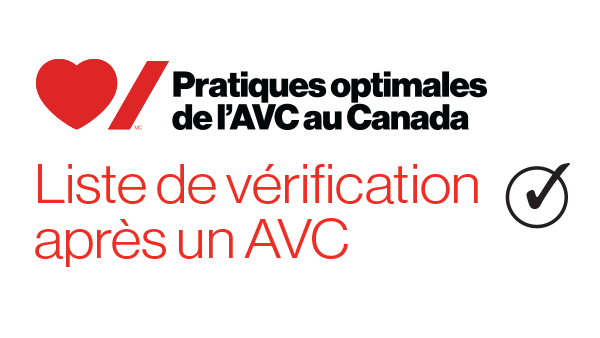- Définitions
- Éléments fondamentaux des services de prévention de l’AVC
- 1. Triage et évaluation diagnostique initiale de l’accident ischémique transitoire (AIT) et de l’AVC non invalidant
- 2. Prise en charge du mode de vie et des facteurs de risque
- 3. Pression artérielle et prévention de l’AVC
- 4. Prise en charge des lipides
- 5. Prise en charge du diabète et de l’AVC
- 6. Traitement antiplaquettaire des cas d’AVC ischémique et d’AIT
- 7. Traitement anticoagulant visant la fibrillation auriculaire
- 8. Prise en charge périopératoire du traitement anticoagulant et du traitement antiplaquettaire
- 9. Prise en charge de la maladie artérielle carotidienne extracrânienne et de l’athérosclérose intracrânienne
- 10. Problèmes cardiaques concomitants chez les personnes ayant subi un AVC
- 11. AVC ischémique associé au cancer
11.1 AVC ischémique associé au cancer
-
Les patients atteints d’une tumeur maligne active qui subissent un AVC ischémique artériel ou un AIT doivent subir un examen étiologique standard pour leur AVC, y compris l’imagerie vasculaire et la surveillance du rythme cardiaque [niveau de preuve C]. Veuillez consulter la section 1 sur les épreuves de laboratoire liées à l’AVC pour en savoir plus.
-
Les mécanismes des AVC associés à une malignité peuvent être pris en considération lors de la détermination des examens étiologiques, y compris l’endocardite non bactérienne (marastique), l’hypercoagulabilité, l’embolie paradoxale liée à une thrombose veineuse, la compression vasculaire liée à une tumeur et les AVC liés aux traitements anticancéreux [niveau de preuve C].
-
Chez les patients présentant une malignité active et un AVC ischémique artériel ou un AIT chez lesquels un état hypercoagulable associé au cancer peut avoir contribué à l’AVC, le traitement anticoagulant peut être envisagé plutôt qu’un traitement antiplaquettaire [niveau de preuve C].
-
En cas de recours au traitement anticoagulant, une héparinothérapie à faible poids moléculaire est préférable [niveau de preuve C]. Le rôle des AOD est inconnu, mais à l’étude. Il peut être raisonnable de les utiliser après avoir pris en compte la préférence du patient.
-
Section 11 Facteurs cliniques
-
Les décisions de prise en charge de ces patients doivent être prises en collaboration avec un professionnel de santé spécialisé en hématologie, en oncologie ou en thrombose. Elles doivent aussi tenir compte du type de cancer sous-jacent, du risque d’hémorragie, de l’étendue de la maladie néoplasique, du pronostic global du patient et des objectifs de soins exprimés.
-
Chez les patients atteints d’une tumeur maligne active et ayant subi un AVC ischémique artériel ou un AIT avec thromboembolie veineuse concomitante (thrombose veineuse profonde ou embolie pulmonaire) chez lesquels on suppose que l’AVC est lié à une embolie paradoxale, le traitement anticoagulant pour la prévention secondaire doit suivre les lignes directrices pour la prise en charge de la TVP et de l’EP chez les patients cancéreux, ce qui comprend l’héparine de faible poids moléculaire (HFPM) et certains AOD (voir www.thrombosiscanada.ca).
Un diagnostic de cancer augmente dans certains cas le risque d’AVC. Il a été constaté que ce phénomène se produit au fil du temps après un diagnostic de cancer, et qu’il est plus fréquent chez les personnes atteintes d’un cancer du cerveau, du poumon ou du tractus gastro-intestinal, ou de cancers plus avancés. Les AVC peuvent résulter de facteurs de risque cardiovasculaire traditionnels, ainsi que de facteurs entraînés par le cancer, notamment l’hypercoagulabilité, l’endocardite thrombotique non bactérienne (ETNB), la compression tumorale directe des vaisseaux sanguins ou les effets liés aux traitements qui potentialisent les AVC. Avec l’augmentation des taux de survie au cancer, il est plus que jamais nécessaire d’évaluer le risque d’AVC et d’optimiser les stratégies de prévention. Le risque d’AVC chez les patients atteints de cancer est deux fois plus élevé que dans la population générale et augmente en fonction de la durée du suivi (Zaorsky et coll., Nature Communications, 2019).
- Systèmes intégrés de soins pour les personnes atteintes de cancer et d’AVC afin de gérer efficacement les rendez-vous et d’assurer la coordination des soins et la sécurité relativement aux médicaments et aux options de traitement.
- Soutien à la recherche en cours sur la relation entre le cancer et les AVC.
- Efforts de sensibilisation et d’éducation des professionnels de la santé et du public
- Proportion des personnes victimes d’un AVC aiguë qui ont également reçu un diagnostic de cancer.
- Délai médian entre le diagnostic de cancer et l’AVC.
- Proportion des personnes atteintes d’un AVC et d’un cancer présentant des biomarqueurs sériques élevés, tels que des taux élevés de D-dimères et de produits de dégradation de la fibrine
- Proportion des personnes atteintes d’un AVC ischémique en phase aiguë et ayant reçu auparavant un diagnostic de cancer qui reçoivent une thrombolyse intraveineuse ou un traitement endovasculaire.
- Proportion des personnes atteintes d’un AVC ischémique en phase aiguë et ayant déjà reçu un diagnostic de cancer qui sont traitées par des antiplaquettaires (ou des anticoagulants et un type précis d’anticoagulant : HFPM, warfarine ou AOD).
- Taux de mortalité des personnes atteintes d’un cancer préexistant qui subissent un AVC en phase aiguë (stratifié selon qu’il est ischémique ou hémorragique).
- Proportion de personnes atteintes d’un cancer préexistant qui subissent un AVC en phase aiguë (stratifié selon qu’il est ischémique ou hémorragique) et qui ont une récidive d’AVC dans les 90 jours, 6 mois ou un an après l’AVC de référence.
Référence : Dardiotis et coll., Int J Oncol. 2019 Mar; 54(3): 779-796. Publié en ligne le 2 janvier 2019. DOI : 10.3892/ijo.2019.4669
Notes sur la mesure des indicateurs
- Les indicateurs de rendement doivent être classés en fonction du type de cancer et des approches de traitement (par exemple, chimiothérapie récente, radiation ou chirurgie).
Renseignements destinés aux dispensateurs de soins de santé
Informations destinées au patient
Cancer-Associated Ischemic Stroke
Evidence Table and Reference List
Increased Risk of Stroke Associated with Cancer
A diagnosis of cancer can increase the risk of stroke in the months or years following the diagnosis, particularly among persons with lung cancer or with more advanced cancers (Navi et al. 2017). In a case-control study including 327,389 persons >66 years, with newly diagnosed breast, colorectal, lung, pancreatic, or prostate cancer shorter term, the cumulative 3-month incidence of ischemic stroke was significantly higher in all types of cancer patients, except for prostate cancer (Navi et al. 2015). For lung cancer, the risk of any stroke was significantly higher at all follow-up points (<1 month, 1-3 months, 3-6 months, 6-9 months, and 9-12 months). Hazard ratios ranged from 1.63 at 6-9 months to 7.43 at < 1 month after cancer diagnosis. The risk of any stroke was significantly higher at one or more follow-up points for all other cancers, as well. Stroke risk may also be increased long-term following a cancer diagnosis, as well. Jang et al. (2019) studied 20,707 persons sampled from a population database with cancer and 675,594 without cancer. The incidence of stroke in both groups was examined up to 7 years after cancer diagnosis using both the entire sample and propensity-score matching. The mean follow-up duration of cancer group was 69.7 months and 82.7 months in the non-cancer group. The cumulative incidence of any stroke using the entire cohort, was significantly higher in the cancer group (3.43% vs.1.07%), as were the cumulative incidences of ischemic stroke (3.10% vs. 0.91%), hemorrhagic stroke (0.46% vs. 0.21%) and death (22% vs. 2.03%). The risk of incident stroke was significantly higher in the cancer group (HR=1.09, 95% CI 1.00-1.18) using data from the entire cohort and was higher when the propensity-matched data were used (HR=1.13, 95% CI 1.02- 1.26). Additionally, the risk of any and ischemic stroke was significantly higher in persons who received chemotherapy (adj HR= 1.21, 95% CI 1.03–1.41 and adj HR= 1.19, 95% CI 1.01–1.40, respectively). Zöller et al. (2012) reported the standardized incidence ratios (SIR) for ischemic stroke following a cancer diagnosis < 6 months previously was 1.6%, which decreased to 1.1% at ≥10 years. The SIRs for hemorrhagic stroke were higher (2.2% at <6 months, 1.2% at ≥10 years and 1.2% overall). Not only is the risk of incident stroke increased following a cancer diagnosis, the risk of recurrent stroke is also increased. Navi et al. (2014) reported the cumulative prevalence of recurrent ischemic stroke were 7%, 13% and 16% at one, 3 and 6 months among 263 patients with active systemic cancer, with a hospital admission for stroke.
Cancer-related Hypercoagulopathy
Thrombosis is a common complication of malignancy and represents a frequent cause of death in cancer patients with a history of stroke. In the OASIS Cancer study (Lee et al. 2017) included 268 patients admitted to a single hospital with an acute ischemic stroke and active systemic cancer. Routine anticoagulation studies (D-dimer, PT, aPTT, fibrinogen and platelet counts) were conducted to assess possible hypercoagulopathy. During hospitalization, plasma D-dimer level was serially monitored after the start of the anticoagulation treatment. The pre-treatment and post treatment plasma D-dimer levels were divided into quartiles and their independent relationship with overall and 1-year survival was examined. Baseline D-dimer levels in the 4 quartiles (Q) were: Q1: <2.08 µg/mL; (25.1%), Q2: 2.08–9.06 µg/mL (24.7%), Q3: 9.06–23.26 µg/mL (25.5%) and Q4: >23.26 µg/mL (24.7%). When Q3 and Q4 groups were combined, the risks of overall and one-year mortality were increased significantly compared with group 1 (reference), HR=2.19, 95% CI, 1.46–3.31 and 2.70, 95% CI 1.68–4.35, respectively after adjustment for stroke mechanism, age, NIHSS score, primary cancer type, cancer histology (adenocarcinoma vs others), and atrial fibrillation. Among a subgroup of 113 patients in D-dimer groups 3 and 4 who were treated with anticoagulants, D-dimer levels were reduced (median of 8.17 µg/mL). Post-treatment D-dimer level was independently associated with poor 1-year survival (adjusted HR=1.03; 95% CI, 1.01–1.05 per 1 µg/mL increase, p= 0.015) but not with overall survival. After discharge from hospital, a D-dimer level of 3.17 µg/mL was identified as the cut-point, above which the risk of death within one month was increased significantly (OR=1.07, 95% CI, 1.04–1.10 per 1 µg/mL increase, p<0.001). Schwarzbach et al. (2012) also reported mean D-dimer levels were significantly higher in patients with active malignant cancer admitted to a hospital following ischemic stroke compared with persons in an age and sex-matched control group (7.64 vs. 5.36 μg/mL, p<0.05). The prevalence of DVT and PE was significantly higher in patients with cancer (8% vs. 1%, p<0.01) and in patients with cancer with an unidentified and/ or cancer-associated stroke etiology compared with patients with cancer with a definite/ probable stroke etiology (15% vs. 1%, p<0.01).
Treatment with Antithrombotics
Navi al. (2018) published one of the only RCTs examining the use of antithrombotics in patients with active cancer who had sustained an ischemic stroke within the previous month. Twenty patients were randomized to receive either subcutaneous enoxaparin (1 mg/kg twice daily) or oral aspirin (81-325 mg/d) for 6 months; however, 6 patients in the enoxaparin group crossed over to use aspirin after a median of 6 days. Treatment groups were too small to conduct inferential statistics. One year after enrollment, three patients in the aspirin group had nonfatal gastrointestinal bleeding and one patient had a nonfatal myocardial infarction. In the enoxaparin group, one patient had a nonfatal pulmonary hemorrhage, and one had a fatal recurrent acute ischemic stroke.
Sex and Gender Considerations
No studies were found that address sex differences on this topic.






